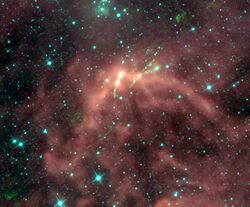Astronomy:Barnard 203
| Molecular cloud | |
|---|---|
| dark nebula | |
 | |
| Observation data: J2000.0[1] epoch | |
| Right ascension | 03h 22m 30.0s[1] |
| Declination | +30° 35′ 00″[1] |
| Distance | 800 ly (250[2] pc) |
| Constellation | Perseus |
| Designations | Barnard 203, LDN 1448 |
The dark nebula Barnard 203 or Lynds 1448 is located about one degree southwest of NGC 1333 in the Perseus molecular cloud, at a distance of about 800 light-years. Three infrared sources were observed in this region by IRAS, called IRS 1, IRS 2 and IRS 3.[2]
The region also contains multiple Herbig-Haro objects, including HH 193–197, which are driven by the protostars in this region.[3]
The young stellar object population
The source IRS 1 is a class I young stellar object and a binary.[4] IRS 1 is more evolved than most of the protostars in this region and less well-studied.
The source IRS 2 is a binary that is very young (class 0 young stellar object), surrounded by a rotating disk and the system shows a bipolar outflow signature. The system has an hourglass shaped magnetic field that is aligned with the bipolar outflow.[5] Towards the east is the source IRS 2E, a source between a pre-stellar core and a protostar.[6]
The source IRS 3B was studied the most and ALMA showed that it is a triple protostar system with one star forming via disk fragmentation. The two outer stars are separated by 61 and 183 astronomical units from the central star and all three stars are surrounded by a circumstellar disk that shows spiral arms. IRS 3B is a class 0 young stellar object and might be younger than 150,000 years. The two protostellar objects in the center have a mass of about 1 M☉ and the protostar further from the center has a mass of about 0.085 M☉. The disk that surrounds the three protostars has an estimated mass of about 0.30 M☉.[7][8] The sources IRS 3A, B and C show molecular outflows.[2] IRS 3 is also called L1448N.
Another well-studied source in this region is called L1448-mm or L1448C. It is a class 0 young stellar object that drives a highly collimated flow, detected in carbon monoxide, Silicon monoxide and water.[9]
References
- ↑ 1.0 1.1 1.2 "Barnard 203". SIMBAD. Centre de données astronomiques de Strasbourg. http://simbad.u-strasbg.fr/simbad/sim-basic?Ident=Barnard+203.
- ↑ 2.0 2.1 2.2 Kwon, Woojin; Looney, Leslie W.; Crutcher, Richard M.; Kirk, Jason M. (December 2006). "Two Bipolar Outflows and Magnetic Fields in the Multiple Protostar System L1448 IRS 3" (in en). Astrophysical Journal 653 (2): 1358–1368. doi:10.1086/508920. ISSN 0004-637X. Bibcode: 2006ApJ...653.1358K.
- ↑ Eislöffel, Jochen (February 2000). "Parsec-scale molecular H_2 outflows from young stars" (in en). Astronomy and Astrophysics 354: 236–246. ISSN 0004-6361. Bibcode: 2000A&A...354..236E.
- ↑ Sadavoy, Sarah I.; Stahler, Steven W. (August 2017). "Embedded binaries and their dense cores" (in en). MNRAS 469 (4): 3881–3900. doi:10.1093/mnras/stx1061. ISSN 0035-8711. Bibcode: 2017MNRAS.469.3881S.
- ↑ Kwon, Woojin; Stephens, Ian W.; Tobin, John J.; Looney, Leslie W.; Li, Zhi-Yun; van der Tak, Floris F. S.; Crutcher, Richard M. (July 2019). "Highly Ordered and Pinched Magnetic Fields in the Class 0 Protobinary System L1448 IRS 2" (in en). Astrophysical Journal 879 (1): 25. doi:10.3847/1538-4357/ab24c8. ISSN 0004-637X. Bibcode: 2019ApJ...879...25K.
- ↑ Chen, Xuepeng; Arce, Héctor G.; Zhang, Qizhou; Bourke, Tyler L.; Launhardt, Ralf; Schmalzl, Markus; Henning, Thomas (June 2010). "L1448 IRS2E: A Candidate First Hydrostatic Core" (in en). Astrophysical Journal 715 (2): 1344–1351. doi:10.1088/0004-637X/715/2/1344. ISSN 0004-637X. Bibcode: 2010ApJ...715.1344C.
- ↑ "Young Stellar System Caught in Act of Forming Close Multiples" (in en-US). https://public.nrao.edu/news/stellar-system-caught/.
- ↑ Tobin, John J.; Kratter, Kaitlin M.; Persson, Magnus V.; Looney, Leslie W.; Dunham, Michael M.; Segura-Cox, Dominique; Li, Zhi-Yun; Chandler, Claire J. et al. (October 2016). "A triple protostar system formed via fragmentation of a gravitationally unstable disk" (in en). Nature 538 (7626): 483–486. doi:10.1038/nature20094. ISSN 0028-0836. PMID 27786204. Bibcode: 2016Natur.538..483T.
- ↑ Nisini, B.; Santangelo, G.; Antoniucci, S.; Benedettini, M.; Codella, C.; Giannini, T.; Lorenzani, A.; Liseau, R. et al. (January 2013). "Mapping water in protostellar outflows with Herschel. PACS and HIFI observations of L1448-C" (in en). Astronomy and Astrophysics 549: A16. doi:10.1051/0004-6361/201220163. ISSN 0004-6361. Bibcode: 2013A&A...549A..16N.
 |


